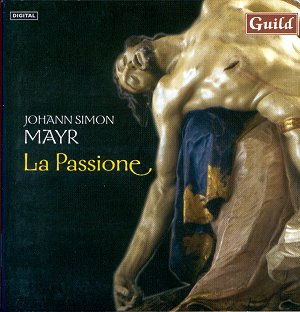I was greatly taken by Guild’s earlier Mayr release,
that of the Mass in C minor which Franz Hauk and his Ingolstadt forces
recorded at the same time as this new release of La Passione and the
Stabat Mater. The Mass was a product of cultural cross-pollination between
the Italian and German schools with strong Haydnesque influences and
echoes of Mozart’s last liturgical works. To this Mayr added some theatrical
spice and indeed borrowings from his own pupil, Donizetti, to create
a work of depth but lyrical persuasiveness. La Passione was written
in 1794 a year which also saw the first performance of his opera Soffo
ossia I riti d’Apollo Leucadio. As befits his cosmopolitan instincts
La Passione is a Venetian oratorio written to a text by an unknown author.
A two-part structure, penitential and devotional, the first centres
around Calvary and the second at the foot of the Cross. The meditative
nature of the oratorio and the concentration on the suffering of Mary
marks it out as a product of the Roman counter-Reformation and distinct
from the works of the Lutheran Bach.
As is consonant with Mayr’s other large-scale choral
works he is here animated by a sense of theatrical involvement. In the
Mass the sense of seething operatic impress occasionally threatened
to break the bounds of liturgical conformity. Here too it is not always
easy to reconcile the contemplative with the dramatic, not least in
those cases of apparent displacement between what is being sung and
the music Mayr chooses to use to invoke it. Thus the very opening Sinfonia,
a bright and bubbly piece of operatic dynamism, is in the notes glossed
as representing the triumph of Light over Darkness. Well, maybe but
its almost lurid optimism, its sense of having being absorbed from another
medium is palpable. It sets up a false premise at least, one that the
Passion struggles not always successfully to accommodate.
There are of course many things to admire. The simplicity
of St John’s Aria Ah Non cercar pietosa with its divisi
strings and pert woodwinds is one of many until, at least, one reads
the words which are deeply at odds with the elfin innocence of the music.
Or the quasi-operatic refinement of Mary Magdalene’s aria Ecco come
il giusto muore. Then there are precise yet compelling little moments
of colour and refinement, dramatically telling such as the affecting
string line that punctuates Mary’s disconsolate recitative Dove sono?
Or the way in which Joseph’s recitative that relates details of
the crucifixion is supported by baleful trombones and rugged string
writing – there is an amplitude of expression in these myriad details
that show Mayr’s mind working on consistently pictorial-dramatic lines.
Mayr delays Mary’s aria for some time, her expression previously transmitted
by recitative alone. When she is given the aria, Nell’ aspro mio
tormento it is rather sturdy and operatic, despite the registral
leaps that are perhaps meant to suggest her agitated state of mind (Maria
Jette is rather taxed by some of the higher notes). Nevertheless there
is in the context a spectacularly jolly duet for Mary and Magdalene,
Nel veder traffito, to end the first part.
The second part, at the foot of the Cross, replicates
the linear curve of Mayr’s schema. There is a splendidly incisive and
galvanising orchestral introduction to the recitative Che vedo with
much opportunity to point the differing responses of those gathered
from the visceral, visual despair of Magdalene to Mary’s reflective
and internalised anguish. In Joseph’s remarkably effective recitative
Quel terribil vendetta for example his vocal line is accompanied
by a sinuously winding oboe and tremolando strings, reflecting and amplifying
his thoughts. The quartet of singers cope relatively well with the various
demands placed on them if not always with either technical or tonal
resources varied enough to enrich the music still further.
The companion work is the Stabat Mater, which was probably
composed in Venice or in Bergamo by about 1802. This is an essentially
traditional setting but as ever with Mayr he is always adept at insinuating
little stylistic quirks into the line. There is a buoyant violin obbligato
in the Eja Mater with its own quite extensive cadenza and the
Fac me tecum which opens beautifully and sustains impetus. The
Virgo virginum is a verdant and entwining duet full of expressive
plangency and the Christe, cum sit hinc commanding and assured.
In fact the whole work is suffused with a clarity and a concision that
serves only to increase its compact success.
Notes are up to the usual Mayr-Guild standard (i.e.
very good) but something has gone awry with the tracking and booklet
text, which doesn’t marry up. One minute you expect a recitative from
Joseph and the next you get an aria from Magdalene. A small liability
but a liability nonetheless. I can’t pretend that La Passione is a blazing
masterpiece – it struck me as inferior to the Mass in C – but in its
intriguing, stylistically various way, it affords many moments of genuine
pleasure.
Jonathan Woolf
